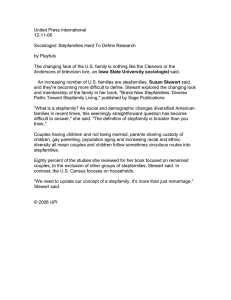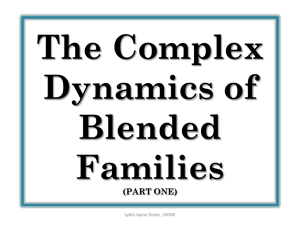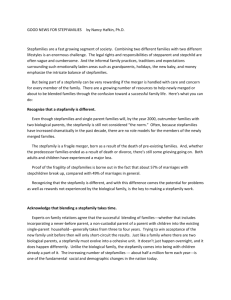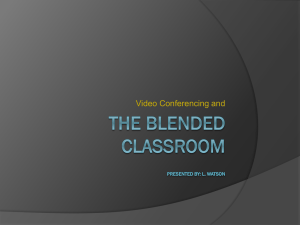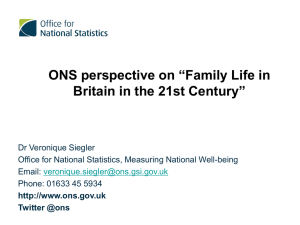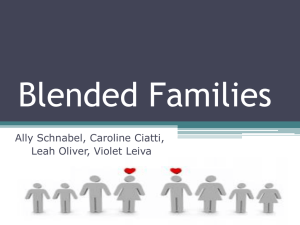PowerPoint - Arkansas School Counselor Association
advertisement
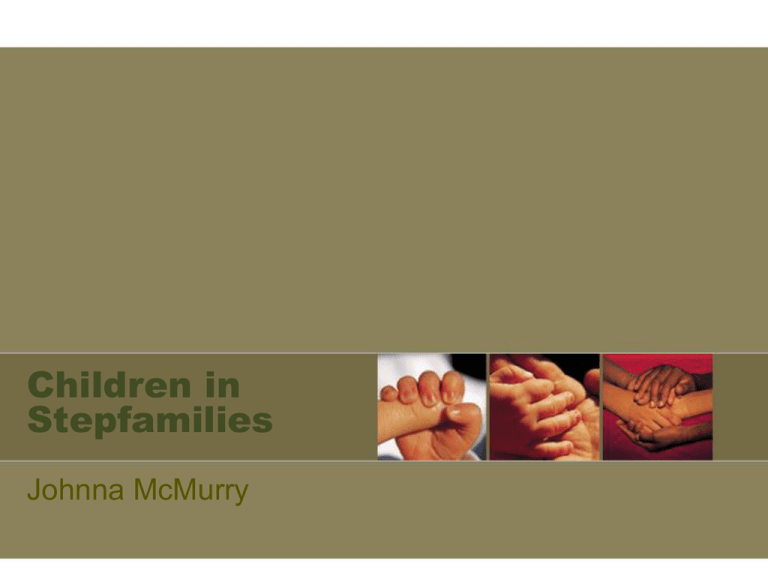
Children in Stepfamilies Johnna McMurry What is a stepfamily? • A STEPFAMILY IS: A family in which one or both of the adult partners bring children from a previous relationship. • Also can be called a blended family. The icon television stepfamily – The Brady Bunch Stepfamily versus Blended Family • Depending on the author, stepfamilies are sometimes called Blended Families. • Blended family is a more positive concept that will have a positive tone instead of the old myth, such as the evil stepmother. History of Stepfamilies According to Professor Lawrence Ganong of the University of Missouri-Columbia, It is estimated that there are the same number of stepfamilies as 100 years ago but that the reason has changed from death of a spouse to divorce. History of Stepfamilies • The U.S. Census Bureau recently decided to discontinue providing estimates of marriage, divorce, and remarriage except those that are available from the 1990 census. • Stepfamilies are not addressed, assessed, and counted which further leads to denial of the affect of stepfamilies on our society. According to the latest statistics… • 1300 new stepfamilies are formed everyday. • 66% of those who remarry breakup when children are involved. According to the latest statistics… • It is estimated that 30% of all children are likely to spend some time in a stepfamily. • One of three Americans is now a stepparent, a stepchild, a stepsibling, or some other member of a stepfamily. How this affects children • According to our text, children of stepfamilies deal with concerns about loss, loyalty, and lack of control. • Lack of control can impact adolescents by increasing the risk of anger or depression stemming from the inability to control their environment. (Vernon, p.269) Issues that stress stepchildren: • Hearing their biological parents argue and put each other down • Inability to see the other parent • Feeling caught in the middle between the biological parents • Fighting within the stepfamilies • Adjusting to rules and discipline set by the stepparent. Underlying issues in stepfamilies • Loyalty, such as loving someone other than the biological parent or feeling forced to choose sides • Loss and grief from the divorce • The ending of the fantasy that their biological parents may remarry. Underlying issues in stepfamilies • Coping with issues that the new marriage has created, such as changing schools, new friends, new neighborhoods, increased distance from a biological parent, and/or economic status. How to help stepfamilies • • • • Brief Therapy Emotionally Focused Family Therapy Group Therapy Individual Therapy Brief Therapy • A time-limited behavioral strategy that can be used in a school or agency setting. • Goal is behavioral change. • Use an instrument like a target behavior form • Counselor supports parental authority, parents should use positive reinforcements that do not allow child more freedom than appropriate. Emotionally Focused Family Therapy • Goal is to promote secure emotional connections between family members • Develop an awareness of each family member’s unique emotional experience • Promotes a “safe environment” to express feelings during the initial phase of therapy Emotionally Focused Family Therapy • During the second phase of treatment, the goal is to reframe the families problem as a pattern. • Therapist works to help the family understand that secondary emotional responses such as withdrawal or pursuit are related to underlying issues of lack of attachment bonds. Emotionally Focused Family Therapy • The final phase, is called the “workingthrough” phase. Families create new patterns that are based on sharing and acceptance of family members attachment needs. Group Therapy • Group Therapy is recommended for adolescence children that are in step-families. • Build opportunity to understand and accept their situation in a supportive climate through such activities as role-play, creative drama, and videotape. • Goal is to finish “unfinished business” and to ensure validation Individual Therapy • Goal is to help adolescent feel they have more control over their environment, which reduces anger and resentment. • Develop coping mechanisms to help child adjust to blended family, while developing a sense of autonomy. • Have an advocate that has no vested interest or baggage in the stepfamily. What can schools do to help? • Be sensitive to issues such as parent/teacher conferences, graduation, and other events. • Be careful about assignments that deal with drawing or talking about parents or family • Include all parents in notices, gifts, and invitations What can schools do to help? • Revise forms to include two sets of parents • In-service for teachers and staff on the sensitivity of stepfamilies. In Review • • • • • Types of Therapy that may be beneficial is Brief Therapy Emotionally Focused Family Therapy Group Therapy Individual Therapy Resources • • http://www.stepfamilies.info/ - National Stepfamily Resource Center The National Stepfamily Resource Center (NSRC) is a division of Auburn University’s Center for Children, Youth, and Families (CCYF). Dr. Francesca Adler-Baeder, Director of the Center for Children, Youth, and Families at Auburn, is the Stepfamily Association of America’s (SAA) former Director of Family Life Education and oversees the activities of the NSRC. http://www.blendedfamily.org/frameset.htm – Blended Family.org This website had some good information on how to handle situations that arise due to blended family. It looks like this site is either new or technology is an issue for the author of the website. I liked the information but could not find who produced this website. I didn’t like the child custody advertisement at the top of the page, it seemed inappropriate. Resources • http://www.blended-families.com/ - Blended Family.com This website has a free newsletter with articles to help blended families but it is a commercial website. It has seminars and materials to purchase also. • http://www.parentingcenter.com/familysupport/stepfamilysupport.html This website has several links to other websites that are helpful when dealing with Stepfamilies. It is sponsored by the Parenting Center.com • www.arkansas211.org - 2-1-1 is a free, easy-to-remember number that connects residents with important community services and volunteer opportunities. Individuals and families seeking social services can call 21-1, a nationally recognizable number that makes a critical connection between callers and the appropriate community-based organizations and government agencies, and get the help they need. My Final Thoughts • Step carefully into a stepfamily • Work to understand everyone’s emotional point of view • As counselors, we should work harder to make all family members feel included in their children’s lives. References • • • • • • • Prosen, S., & Farmer, J. (1982). Understanding stepfamilies: Issues and implications for counselors. Personnel & Guidance Journal, 60 (7), 393-397. Retrieved September 25, 2008, from PsycINFO database. Mason, M.A.. (2008). Stepparents in the United States. In Encyclopedia of Children and Childhood in History and Society. Retrieved September 23, 2008, from http://www.faqs.org/childhood/So-Th/Stepparents-in-the-UnitedStates.html. Jones, J.. (February 18, 2004). MU Professors Examine Dynamics, History of Stepfamily Households. In Missouri.edu. Retrieved September 20, 2008, from http://web.missouri.edu/~news/releases/stepfamilyrelationships.html. Furrow, J., Palmer, G.. (November 4, 2007). EFFT and Blended Families: Building Bonds from the Inside Out. In Journal of Systemic Therapies. Retrieved September 20, 2008, from http://www.atypon-link.com/GPI/doi/pdf/10.1521/jsyt.2007.26.4.44?cookieSet=1. Stewart, S.D.. (2007). Statistics on Unmarried, Cohabitating and Gay and Lesbian Stepfamilies.. In Stepfamily Foundation. Retrieved September 20, 2008, from http://www.stepfamily.org/statistics.html. Unknown. (2006-2008). Stepfamily Fact Sheet. In National Stepfamily Resource Center. Retrieved September 20, 2008, from http://www.stepfamilies.info/faqs/factsheet.php. Vernon, A.. (2004). Counseling Children & Adolescents. Colorado: Love Publishing Company.
